Services on Demand
Journal
Article
Indicators
-
 Cited by SciELO
Cited by SciELO -
 Access statistics
Access statistics
Related links
-
 Cited by Google
Cited by Google -
 Similars in
SciELO
Similars in
SciELO -
 Similars in Google
Similars in Google
Share
Profile: Issues in Teachers' Professional Development.
Print version ISSN 1657-0790On-line version ISSN 2256-5760
profile no.6 Bogotá Jan./Dec. 2005
Sonia Rocío Ríos Olaya1, Ana Milena Valcárcel Goyeneche2
1sonrorios25@yahoo.com
2Institución Educativa Distrital Luis López de Mesa
anagoye@yahoo.com
This project involved three different groups of seventh grade, at the Luis López de Mesa state school in Bosa, Bogotá (Colombia). Thinking of a way to adapt the foreign language learning-teaching process to our real conditions, we found reading very useful to enable students to learn English more easily and accurately. We show how English language learning can be developed from reading processes involving the other language skills and can help students to develop individual and social skills. We conclude that reading becomes a meaningful way to learn a foreign language when teachers choose reading material according to learners’ interests, age and needs, and other content areas.
Key words: Reading, English language, meaningful reading, action research
Este proyecto involucró tres grupos diferentes de estudiantes de grado séptimo del colegio Distrital Luis López de Mesa en Bosa, Bogotá (Colombia). Pensando en una manera de adaptar el proceso de enseñanza-aprendizaje de un idioma extranjero a nuestras condiciones reales, encontramos que la lectura es muy útil para que los estudiantes aprendan inglés de manera más fácil y precisa. Mostramos cómo se puede desarrollar el aprendizaje del inglés a partir de la lectura involucrando las otras habilidades del lenguaje y ayudando a los estudiantes a desarrollar habilidades individuales y sociales. Concluimos que la lectura es una forma significativa de aprender una lengua extranjera cuando los profesores eligen el material de acuerdo con los intereses, edades y necesidades de los estudiantes, y otras áreas del conocimiento.
Palabras claves: Lectura, lengua inglesa, lectura significativa, investigación-acción
INTRODUCTION
Reading strategies are associated with different aspects of language learning and cognitive processes, and the effects can only be observed if reading becomes a habit. We have observed that it is necessary to consider aptitudes, motivation and the learners’ capacity to understand any type of text. It is also important to develop strategies to motivate students to read as well as to help them achieve a good comprehension level.
That is why the readings have to be selected taking into account the readers’ needs, interests, experiences, previous knowledge and their real environment to make the language learning process meaningful, useful and practical. In fact, reading is an individual process which develops self-study habits. Our concerns are related to how students can be motivated to read, what kind of activities should be carried out and how, the development of the other language skills from reading, and the possible difficulties we can have when applying, making or choosing a reading activity.
THEORETICAL FRAMEWORK
Reading is a receptive language process in which the reader recognizes and decodes any kinds of symbols. This process ends when the reader gives sense and meaning to the decoded written language and transfers the information understood in his experience and thought.
Reading comprehension is extracting efficiently what is essential in a written text. It is a gradual process, which includes different skills and depends on readers’ previous knowledge and experiences. It is through language that people make things meaningful to each other, interact and communicate ideas. The social environment along with the experiences pupils have affect the development of the reading skill because reading operates in a social context. According to the readers’ background and individual characteristics, each reader gives his own meaning to the reading; thus, there may be a lot of different meanings for the same text.
Every reading process takes place in different stages (Carrell et al., 1988) and involves symbol recognition, prediction, confirmation, correction, and termination. Teachers must be conscious of these different stages and, depending on people’s awareness of these stages, help students develop reading skills successfully.
Having a reason to read is very important when developing reading skills. Reading has a communicative function which lets us improve and reinforce knowledge. It also offers us opportunities to entertain and broaden cultural appreciation. Native speakers can learn more easily to read the tongue they have understood and spoken since birth, then they transfer this previous knowledge to the English reading process. Some of them are:
1. Sensitizing: Its aim is to provide the reader with unfamiliar words, new structures, complex or obscure sentences.
2. Inferring: It is the use of syntactic, logical and cultural clues to find out the meaning of unknown elements.
3. Prediction: It is given in the images, pictures, charts, etc., that accompany the reading. It implies confirmation of expectations.
4. Skimming: It is getting the general idea of a text.
5. Scanning: It is to focus on specific information.
6. Extensive Reading: It is to read, for your own pleasure, without understanding every word.
7. Intensive Reading: It is the act of reading short texts pointing out specific information (Bowen and Marks, 1994, p.45).
Just as techniques, strategies to read must be selected according to the nature of the text and the purpose of the reading, reader’s age, interests, environment and other aspects named before.
On the other hand, when we evaluate reading skill development, we not only evaluate students’ results, but a complete process which involves all members in it, such as teachers, peers and the student him/herself. To ensure effective evaluation we estimate the process as well as the results obtained through different strategies. Evaluation shows teachers’ and students’ strengths and weaknesses regarding different strategies employed in class. “Evaluation is an integral part of the learning process. The role of evaluation is to give teachers and students feedback that will determine adjustments and re-planning of the work in hand to ensure that learning takes place effectively and efficiently” (Estaire and Zanon, 1994, p.34).
Our concern had to do with the development of the reading skill in a meaningful way. For carrying out this project we started with these questions:
• What do students like and not like reading?
• How can students be motivated to read?
• What obstacles appear when getting students interested in reading?
• What obstacles appear when developing reading skills?
• What do reading processes tell us about English language learning?
METHODOLOGY
We think that reading is a very good resource to make students become conscious of their own learning processes. Through this skill, they are sometimes able to realize what weaknesses or strengths they have in the target language. This research was developed with students of seventh grade in both shifts at Luis López de Mesa School: in the morning, room 701; in the afternoon, rooms 701 and 702. The first group, 701 morning, has 42 students between the ages of 11 and 15. The other groups are almost the same, 701 with 39 students, ages 10 – 13, and 702 with 43 students, ages 12 – 14. These students belong to a low socio-economic level. Their English level is very low because they only have the opportunity of learning English at school. Moreover, in their social context, learning a foreign language is not of much use.
We also wanted to innovate because this was the first time a reading project was developed as such. Moreover, this project definitely helped us to improve our job as teachers because we consider reading to be a very useful means to get enough input in order to learn a language. That is why this study was developed following the action-research approach. We incorporated a possible solution for the lack of interest in learning English as a way to improve our job by involving learners, teachers and researchers. The findings were based on our daily work and students’ constant evaluation, adaptation, and improvement.
Action research addresses our efforts regarding group social situations in order to confront common problems including people who are involved in them. This kind of research has been very useful regarding educational problems. Action research carries out a rationalized six-step procedure, to wit: identifying problems, analysis of problems, formulating ideas or hypotheses, gathering and interpreting data, implementation -action and evaluating the results of action (Burns, 1999). This research allows a very practical and continued improvement of the learning processes.
We started out with a questionnaire and found out what students like reading. At the same time, we designed a consent form in which students and parents were informed of the project, and they gave us permission to develop the project with their participation.
We chose and selected reading material taking into account the results of the survey about students’ preferences. After that, we planned guides to work the different readings, containing pre, while and post reading activities. Then, we applied some readings and evaluated the students’ reading skill in the foreign language through different activities developed in class.
We checked on students’ processes in the application of the readings, students’ performances, the achievement of objectives laid out at the beginning of every activity, and finally, the resulting materials from all the activities applied. We monitored students’ behavior and acceptance of this project. We also thought about the way in which we could integrate the different subjects and language skills.
Data collection was obtained from different sources, to wit:
a. A Survey: It was applied before selecting the reading material. This allowed us to learn of students’ likes, dislikes and the activities they like to do.
b. An Interview: It was applied after the implementation of some readings. Its purpose was to know how students felt about the project, what progress they had experienced and a critical evaluation of their own processes.
c. Field Notes: We took field notes as we were developing the project. They were taken during and after the classes. They contained our perception of some of the students’ reactions or feelings about the readings. They also showed our perception of the students’ progress in their learning processes.
d. Recordings: All class activities were recorded using videos or tapes. Those were done to observe in detail students’ attitudes, reactions and behavior during the application of the readings.
FINDINGS
We focused our project on the students’ likes, motivation towards reading, the possible ways to get students interested in reading as well as the difficulties or strategies to foster English language learning. The analysis of our findings led us to four categories as shown in the following diagram.
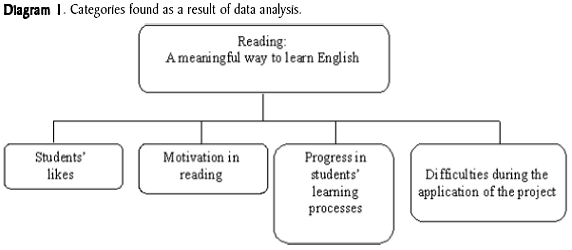
Students’ Likes
After analyzing the results and conclusions the survey revealed, we started to look for and make reading material. We started to select, elaborate and apply reading activities, and the success students had was because they fulfilled many requirements that make a good reading exercise such as readers’ interest, age, visual support as well as students’ likes and activities they like to develop during and after the readings. The reading process must be learner-centered. We also tried to include the application of more than two reading techniques which guaranteed a better development of this skill.
Four guides were applied. The topics worked were the seasons, the Olympic games, daily activities and Halloween (See Appendix 1, 2, 3, and 4). While using these guides we realized that students liked them a lot because all these readings were related to their reality. They had already seen T.V. news about the Olympic games in Athens so it was interesting for them to know about this in English. Besides, sports is one of the topics they prefer. The guides also included some questions which intended to get some information about themselves.
The post-reading activities let them talk about their own reality. For instance, they had to talk about their daily activities; they had to describe their or another partner’s clothes or the way they used to celebrate Halloween. In another case, they had the opportunity to describe themselves, the teacher or other people in a fashion show which was funny and enjoyable.
According to what students said after the implementation of the guides, they learnt to read and speak about other topics using the English anguage. This shows that teachers can get better results in the learning process when activities are learner-centered.
Motivation in Reading
During the whole process we realized that there are aspects connected to the motivation for reading. These aspects are shown in the following diagram:
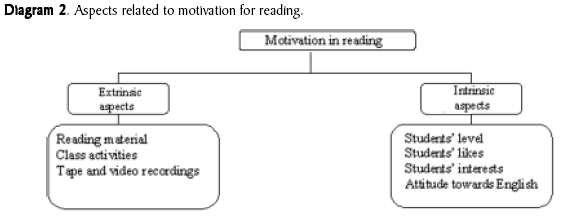
Motivation has become one of the key concepts to take into account in any learning process. A person who is motivated to do something can get better outcomes. That is why we must show our students the sense and reasons for reading.
Reading is not just a process of identifying letters and the main idea of a paragraph. Reading has a broader context. Reading is a way to communicate and understand our environment; consequently, it must have a specific intention or purpose. It is a way to open our minds to other cultures and fields of knowledge. Reading can be a tool to explore the world, other cultures and compare them with our own. Thus, teachers must show that we always read to give meaning to the world and the world comes to us through reading, too.
If the reading material is elaborated taking into account the learners’ interests, age, likes and level we can guarantee at least the learners’ attention. We applied this principle to select and elaborate the readings and the activities. The guides not only expanded students’ vocabulary and reinforced the use of structures more properly, but they also promoted learner’s creativity and imagination; they encouraged them to produce different speeches in the target language.
As far as extrinsic aspects are concerned, reading material must call students’ attention; it needs to be very creative, clear and specific. The material must also be designed with pre, while and post-reading activities which ensure the comprehension of the text.
The post reading activities point at students’ reality. These activities encourage students to talk about one aspect of their lives which not only makes the learning process more meaningful, but also allows students to reinforce the structures and vocabulary learnt.
The guides also promoted meaningful reading because the topics and activities were based on real situations or events that were happening. Some students became conscious that they were using English to communicate ideas, to receive and give information. In that way English was being useful and meaningful, a tool to communicate. Here there are some comments students made after the implementation of the project:
Student J: Me gustaría continuar con esta actividad el otro año porque, porque entre más aprendamos lecturas y eso, y textos en inglés más estamos avanzando; el otro año me gustaría leer sobre las universidades y todo eso.
I would like to continue with this activity next year because the more we learn with readings and texts in English, the more we improve; next year I would like to read about universities, and the like.
Student B: Me gustaría más lecturas de deportes, y de comparaciones con otros países, porque a mí sí me gustó la de Halloween, puesto que nos hacía pensar en nuestras costumbres ¿sí?, y compararlas con otros países.
I would like more sports readings and comparisons with other countries. I liked the Halloween reading because it made us think about our customs, and compare them with those of other countries.
We have also found the implementation of these guides as a tool to encourage students’ self-study and team work. Students helped each other when necessary and they also concentrated on their tasks. In addition to this, some students wanted to learn English because they like it; they had a good attitude towards this language, which encouraged them to do their best, too. Another aspect that motivated them was the use of tape and video recordings; they were a new experience for them, so, they got excited and wanted to participate more.
Students don’t have money to buy textbooks so working with the guides lets them have and handle their own material and keep it in a folder. The guides have also encouraged students to practice reading and realize that they can improve their reading comprehension skills by themselves, by doing what they like best, namely: coloring, looking at pictures, completing puzzles, ordering sentences, etc. All this has made reading an entertaining activity for the students.
Progress in Students’ Learning Processes
The guides were designed with several activities that involved, in a certain way, the four language skills which are listening, speaking, reading and writing. Reading is a process to get some input but we think it also helps students to produce simple writings. Students were asked to write some paragraphs about the topics studied in the readings, and as already mentioned above students were interested in doing those short writings because they encouraged them to express ideas about themselves. Students spoke mixing both languages, the native and target one, even though some students have got some problems pronouncing some words and sentences. They tried to create some simple questions using what they knew. For example:
Student X: Teacher, what is winter?
Student Y: Teacher y el three?
Student Z: Question teacher, please!
Student G to student F: ¿Cierto que esto es un sweater? (This is a sweater, isn’t it?)
The activities designed for the guides as well as the way they were developed promoted the enhancement of the speaking skill. Some students really liked to participate by reading aloud, discussing, doing the corresponding dialogues or just reading on their own. Others were very shy and preferred being quiet, listening to the others and repeating when they were asked to do so.
The listening skill was also promoted. Activities like listening to the teachers’ pronunciation, listening to themselves or to other students motivated the development of this skill. They had to listen to the explanations or instructions and this way we could evaluate their comprehension too. Students really improved their pronunciation and in the last reading were more comfortable reading and participating. It was also important to see students realizing and correcting mistakes their partners made in pronunciation. However, those students who were not very outgoing kept on making some mistakes not only with the pronunciation but also with the structures. This shows that it is very important to pay attention to all students, and especially to those who have more difficulty with the language. Trying to promote everybody’s participation is relevant and necessary.
Writing was also worked during the application of the guides. Students were asked to write short paragraphs, to answer questions, to make posters, to do some grammar exercises and to practice spelling the new vocabulary. The writings showed the association students established between the mother tongue and the target language structures. They mixed them up. It was also difficult for them to differentiate the spelling from the pronunciation.
Difficulties during the Application of the Project
We also had some difficulties during the implementation of the project. To present them we divided them into two groups. The first one refers to some external obstacles and the second one has to do with some difficulties students have in the English learning process.
a. External difficulties
Time was short because some activities at the school were scheduled at the same time we had the English class. Many English classes did not take place so the application of the guides had to be put off many times.
Some conditions of the building such as the lack of electrical plugs and the distribution of the classrooms made teachers and students move to another classroom, which made teachers waste time.
b. English learning process
Even though some students were very focused when working on the guides, a few students did not stop bothering, interrupting the normal development of the tasks and creating some discipline problems. According to what we observed in the classes those students do not really like English. They gave different reasons, which were recorded in surveys and the field notes and are the following:
• English is not necessary for their lives.
• English is very difficult.
• They do not understand.
• They are not interested in learning English.
• They have no skills for foreign languages.
We faced these problems by persuading them of the importance of learning a foreign language and trying to break up some false ideas or conceptions they had towards the English language.
Assimilation of the mother tongue structures to the structures of the target language is a very common problem in students’ written and oral productions. Some of the difficulties found in our project were the following:
Order of words: Students made up sentences based on the mother tongue structures, in this case Spanish: (Subject = noun (adjective)) + verb + complement (noun + adjective). They sometimes left out the subject, (especially when it was a pronoun), perhaps because in Spanish you can do it. For example:
When they had to name a noun with an adjective they used to write the adjective after the noun. Here are some samples of this difficulty:
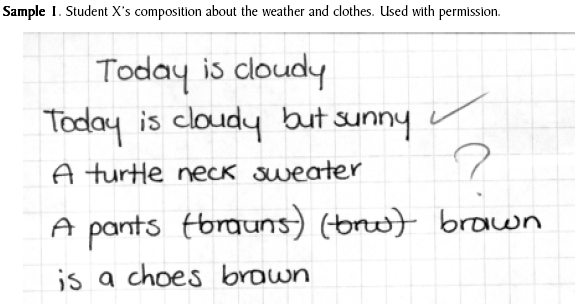
Many techniques were used to correct that common mistake. Writing exercises where students had to describe an object or a person using certain adjectives were given. As they were speaking, the teacher made a sign with her fingers to show that they had to change the order and they corrected their mistakes.
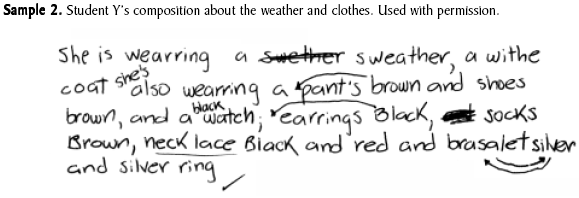
When students were telling time, it was also common to prefer the structure similar to Spanish; besides, it was the easiest way to tell time. Another big problem with the language was the use of third person singular in present tenses. They wrote sentences without paying attention to this grammatical rule.
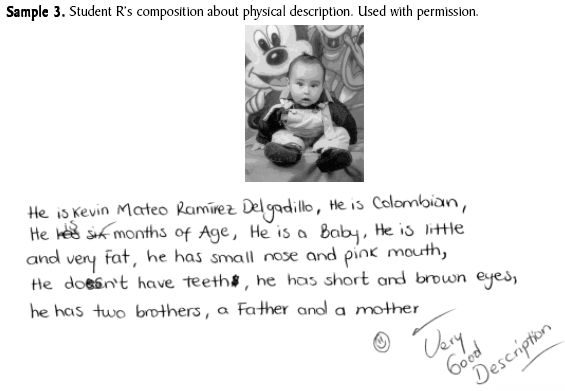
The articles a, an and the became a problem for some students. Some of them not only did not differentiate their use with a singular noun but also used them with plural nouns. This difficulty was worked on by doing several exercises in which students were asked to name some nouns using the indefinite articles and some adjectives. For example:
A red jacket
An intelligent boy
The intelligent students
An airplane
A beautiful girl
A university
An orange umbrella
An eraser
The schools
As far as pronunciation, we could see that students are used to reading words in English as they are written. This is because of the process they have experienced acquiring the mother tongue. This difficulty was worked out with some students by having them repeat the word(s) several times until they got the correct pronunciation. Another difficulty was the lack of vocabulary. In spite of doing some pre-reading activities where new vocabulary and some structures were presented, many students asked for the meaning of words or structures. As a result, we could confirm that teacher guidance and the use of dictionaries are relevant.
DISCUSSION
Using reading as a meaningful tool to learn English is an important way to promote two aspects which not only ensure the quality of the process but also support the development of values.
Extending reading to other content areas was also possible. As students have already found that reading English is fun, useful and easy, we can start to apply different reading texts involving the other content areas. They can learn more not only about the language but also about other subjects like social sciences, physical education, religion, philosophy, and biology, among others. This process not only guaranteed the use of English to read in other subjects (making it meaningful), but also the application and reinforcement of the other fields of knowledge.
In addition, we were able to promote self-study by creating reading habits. Students were motivated to choose their own readings to be applied to themselves. They could also participate in the design of the guides. These facts encouraged them to improve on some values like responsibility and autonomy. Additionally, they did some extra exercises they had not been asked to do, like drawings about some topics. They also collected all the material given out in a folder as well as some extra pages that a few of them had downloaded from the Internet.
CONCLUSIONS
From the application of the project we can conclude that reading activities have to be selected according to students’ likes. This means readings should be learner-centered. We have realized that reading is an interesting way to motivate the English learning process in students because they can learn more in an entertaining way. This is also a very interesting project to be implemented by English teachers because other language skills may be developed from the reading activities.
Another relevant aspect to take into account is to design the guides properly in relation to students’ likes, level, interests and contexts. With better planning and design of reading resources, there will be better results in the English language learning process. The application of these reading activities not only reinforces vocabulary, grammar and other knowledge but also students’ values such as responsibility, autonomy and respect for others.
The reading process is developed better when the reader has a specific intention or purpose; thus, reading becomes a meaningful action. Lastly, it should be stressed that when learners realize that English can be a tool to access other content areas, they find it useful and motivate themselves in the English learning process.
ABOUT THE AUTHORS
Sonia Rocío Ríos Olaya: B. Ed. in Spanish and Languages from the Universidad Pedagógica Nacional. She is currently doing a specialization in Pedagogía de la Comunicación y Medios Interactivos at the Universidad Distrital Francisco José de Caldas.
Ana Milena Valcárcel Goyeneche: B. Ed. In Philology and Languages from the Universidad Libre. She has a specialization in Edumática with emphasis in multimedia sources from the Universidad Autónoma de Colombia. She has worked with students from kindergarten to technological levels. Since her graduation she has been interested in ELT and has participated in several in-service courses.
REFERENCES
Bowen, T. and Marks, J. (1994). Inside teaching. Oxford: Macmillan. [ Links ]
Carrell, P. et al. (1988). Interactive approaches to second language reading. Cambridge: Cambridge University Press. [ Links ]
Estaire, S. and Zanon, J. (1994). Planning classwork. A task-based approach. Oxford: Heinemann ELT. [ Links ]
Burns, A. (1999). Collaborative action research for English language teachers. Cambridge: Cambridge University Press. [ Links ]














